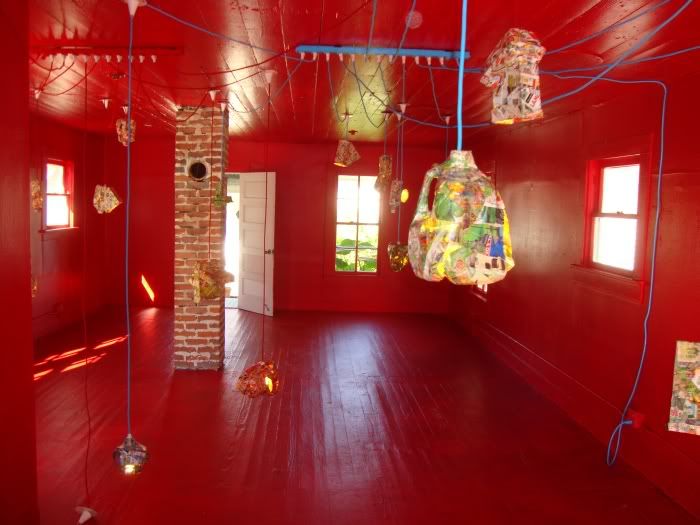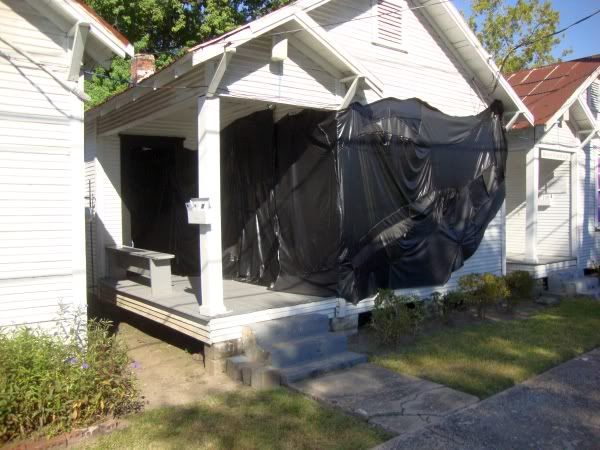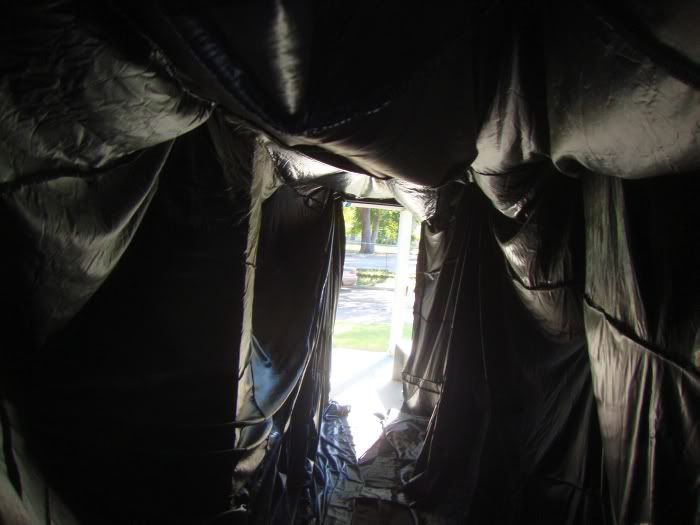Edgar Arceneaux and Nery Gabriel Lemus were the co-curators. The six artists apparently all know each other--the description of the show by the curators says, "The Seventh House was intended to be a vessel that expressed the nature and attributes of the dialogue that informed several years of numerous discrete collaborations between six artists." All but one of the artists studied at CalArts. Like many PRH shows, this one is at least somewhat political. That is to say, any given row house in this exhibit is likely to have an explicit political message. (Each artist had his or her own row house to use as an installation space.) My problem is that I agree with Edward Winkleman, who wrote "most political art not only sucks, it can barely aspire to sucking"

Andrea Bowers, Hope in Hindsight, installation, 2010
For instance, this piece by Andrea Bowers. She has painted the outside of the row house with something Obama said in 2006. Inside she has a poster image of a smiling African-American teenager wearing a tee-shirt that portrays Obama as a superhero. The poster also has an extremely hopeful text from Obama's inauguration. Then there are two videos playing, one showing crowds at the inauguration, and one showing the extremely disappointed African-American woman from a recent Obama town hall meeting. The basic message is, Obama, you let us down!
I'm sorry, this is a really shallow message. Anyone who expected Obama to be a superhero was deluding herself. Obama, working in the political environment of an unusually bad economy, managed to get through the biggest reform in health care and biggest financial industry reforms in decades. Honestly, if the economy wasn't so bad, liberals would be showering Obama with praise. What he's done is remarkable. But apparently some people--including Andrea Bower?--expected him to be Superman.
But! Look at that house. It looks great. That's the thing. I am a hedonist; I like things that are visually beautiful or cool or whatever. Things that, when I look at them, I want to say, "Wow!" And this row house qualifies. This tension between super-obvious, kind-of-shallow-and-unnuanced political message on one hand and a big visual wow on the other typifies this PRH show.

Olga Koumoundouros, Accumulation of Mondays, installation, 2010
For example, look at this freaking red room by Olga Koumoundouros. I love it! The intensity of the red, the blue cables, the mysterious hanging objects. Walking into it from Holman Street just gives you this injection of visual energy. This photo barely does justice to it. But what does it mean? Let's refer to the text...
Human sustenance looms large in our emotional life as we strive for resources that are inequitably distributed [...] By indicating the drive for upward mobility that economic disparity in American society forces, "Accumulation of Mondays" operates as an exaltation of the socio-political idea that human sustenance is a right for all.See, the hanging objects are grocery items wrapped with supermarket circulars. And the fact that some Americans struggle to get enough while some have plenty is bad. This message would be totally unintelligible without the written text, and as a political message it is utterly banal. And a message like this, with no solution attached, feels like the laziest kind of posturing. (That said, PRH is an exemplary organization in the sense that in addition to exhibiting political art devoted to social justice issues, it actually does something about it. Check out their website to see what PRH does for the community--it's amazing.)
So here I am dismissing Koumoundouros's message while loving her work. I can't easily reconcile these mixed feelings. But there it is. (Go see this work--it is striking and beautiful. And its beauty must be problematic for the artist. A work about the injustice of poverty shouldn't provide aesthetic pleasure, should it?)
Not everything in this show is overtly political. Rodney McMillian (the one artist of the six who didn't go to CalArts) has taken black vinyl and sewn it into an interior space for a row house. You start from the outside.

Robert McMillian, portal: a state of kemmering in the Council-era of corrosion, installation, 2010
Then you walk into this vinyl-covered space through the house.

Robert McMillian, portal: a state of kemmering in the Council-era of corrosion, installation, 2010
What does this title, portal: a state of kemmering in the Council-era of corrosion, mean? He writes "The project was created in thinking about the portal in terms of transformation: physical, psychological, and metaphysical." I think the title is referring to The Left Hand of Darkness, the feminist science fiction novel by one of my favorite authors, Ursula LeGuin. In this book, a representative from Earth is on a planet of humans who have been separated from the main stream of humanity for thousands of years. They have (either through evolution or through genetic engineering--I can't remember) become hermaphrodites, who for most of any given month are basically sexless, only becoming either male or female during two days of the month--a time called kemmer. Kemmering is is the state of having a gender, and pairs often swear to one another to be devoted during kemmering.
The way McMillian's house is set up forces you to go through it, from the front door to the back. So I am interpreting this portal as the space where one resolves into a specific gender for kemmer. It's the biological decision space. Or is it? McMillian doesn't offer up a lot of clues, which is the way I like it.
(For a truly vicious review of McMillian's work, see this review by Leah Ollman of a show in L.A. at Suzanne Vielmetter Los Angeles Projects. McMillian used sewn vinyl elements in that show as well. Suzanne Vielmetter is the gallery home for most of the artists in this show.)
So you can see why I have mixed feelings. And perhaps you see why I say go and see the show.




No comments:
Post a Comment